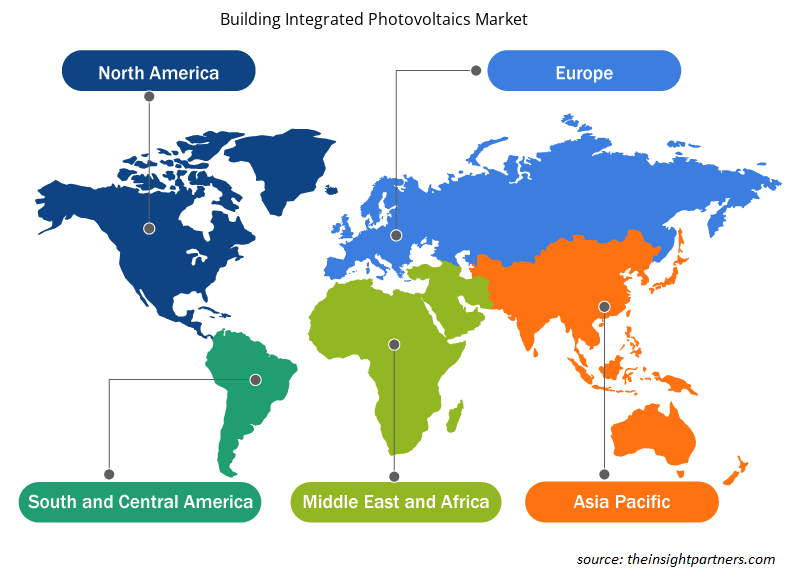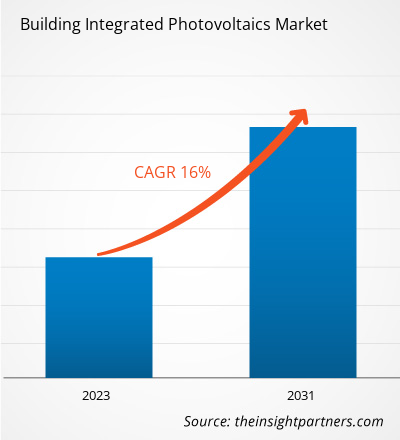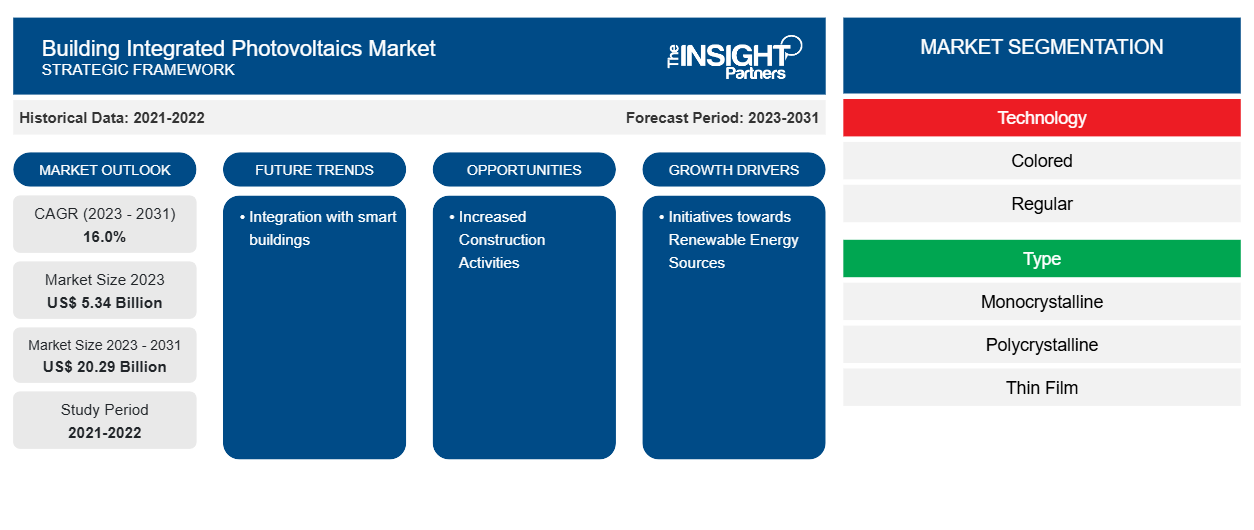Der Markt für gebäudeintegrierte Photovoltaik wird voraussichtlich von 5,34 Milliarden US-Dollar im Jahr 2023 auf 20,29 Milliarden US-Dollar im Jahr 2031 anwachsen. Der Markt wird zwischen 2023 und 2031 voraussichtlich eine durchschnittliche jährliche Wachstumsrate von 16,0 % verzeichnen. Die Integration in intelligente Gebäude wird voraussichtlich ein wichtiger Trend auf dem Markt bleiben.
Marktanalyse für gebäudeintegrierte Photovoltaik
Die steigende Nachfrage nach erneuerbarer Energie, kombiniert mit der Elektrifizierung des Transportwesens und der stärkeren Einbindung von Öl- und Gasunternehmen in die Strom-Wertschöpfungskette, beschleunigt die Konvergenz der Endverbrauchsindustrien.
Marktübersicht für gebäudeintegrierte Photovoltaik
Gebäudeintegrierte Photovoltaik (BIPV) sind Produkte oder Systeme zur Erzeugung von Solarstrom, die nahtlos in die Gebäudehülle integriert sind und als Gebäudekomponenten wie Fassaden, Dächer und Fenster fungieren. Ein gebäudeintegriertes Photovoltaiksystem (BIPV) wandelt Sonnenenergie in Elektrizität um und bietet gleichzeitig Wetterschutz, Wärmedämmung, Lärmreduzierung, Tageslichtbeleuchtung und Sicherheit. BIPV-Systeme können während der Bauphase eines Gebäudes installiert oder als Teil einer Nachrüstung eines bestehenden Gebäudes eingesetzt werden, wenn eine der Außenkomponenten ersetzt werden muss. Die gebaute Umgebung bietet eine Vielzahl von BIPV-Integrationsoptionen.
Passen Sie diesen Bericht Ihren Anforderungen an
Sie erhalten kostenlos individuelle Anpassungen an jedem Bericht, einschließlich Teilen dieses Berichts oder einer Analyse auf Länderebene, eines Excel-Datenpakets sowie tolle Angebote und Rabatte für Start-ups und Universitäten.
-
Holen Sie sich die wichtigsten Markttrends aus diesem Bericht.Dieses KOSTENLOSE Beispiel umfasst eine Datenanalyse von Markttrends bis hin zu Schätzungen und Prognosen.
Markttreiber und Chancen für gebäudeintegrierte Photovoltaik
Initiativen für erneuerbare Energiequellen fördern den Markt
Der weltweite Markt für gebäudeintegrierte Photovoltaik wird von den Bemühungen zur Förderung erneuerbarer Energien angetrieben. So beabsichtigt die Biden-Regierung, fossile Brennstoffe als Energiequelle in den Vereinigten Staaten bis 2035 auslaufen zu lassen. Das Weiße Haus verkündete das Ziel, bis 2030 80 % erneuerbare Energie zu erzeugen und fünf Jahre später 100 % CO2-freien Strom zu erzeugen. Gebäudeintegrierte Photovoltaik erzeugt Solarstrom, indem sie traditionelle Gebäudeelemente wie Dächer, Oberlichter und Fassaden ersetzt. Die zunehmende Betonung erneuerbarer Energien und Nachhaltigkeit trägt zur Expansion der BIPV-Branche bei.
Erhöhte Bautätigkeit
Die zunehmende Bautätigkeit, insbesondere in Schwellenländern, treibt die Branche der gebäudeintegrierten Photovoltaik (BIPV) voran. Die rasche Urbanisierung und der Bau neuer Gebäude bieten Aussichten für die Implementierung von BIPV-Systemen. Der steigende Bedarf an neuen Gebäuden treibt die Expansion der BIPV-Branche voran. Das American Institute of Architects schätzt, dass die Investitionen im Bausektor im Jahr 2024 insgesamt um 6 % steigen werden, wobei der Anstieg bei gewerblichen, industriellen und institutionellen Strukturen bei 3 % liegt.
Marktbericht zur gebäudeintegrierten Photovoltaik – Segmentierungsanalyse
Wichtige Segmente, die zur Ableitung der Marktanalyse für gebäudeintegrierte Photovoltaik beigetragen haben, sind Technologie, Typ, Anwendung und Endverbrauch.
- Basierend auf der Technologie ist der Markt in farbig und normal segmentiert. Das farbige Segment hatte im Jahr 2023 einen bedeutenden Marktanteil.
- Je nach Typ ist der Markt in monokristalline, polykristalline und Dünnschicht-Elektronik unterteilt. Das monokristalline Segment hatte im Jahr 2023 einen größeren Marktanteil.
- Basierend auf der Anwendung ist der Markt in Dächer, Wände, Glas, Fassade und andere unterteilt. Das Segment Dächer hatte im Jahr 2023 einen größeren Marktanteil.
- Basierend auf der Endnutzung ist der Markt in Industrie, Gewerbe und Wohnen segmentiert. Das Wohnsegment hielt im Jahr 2023 den größten Marktanteil.
Gebäudeintegrierte Photovoltaik Marktanteilsanalyse nach Geografie
Der geografische Umfang des Marktberichts zur gebäudeintegrierten Photovoltaik ist hauptsächlich in fünf Regionen unterteilt: Nordamerika, Asien-Pazifik, Europa, Naher Osten und Afrika sowie Süd- und Mittelamerika.
Das Wachstum des Bausektors in den nordamerikanischen Ländern, gepaart mit einer Zunahme an Gewerbeflächen, ist der Schlüsselfaktor für das Wachstum des Marktes für gebäudeintegrierte Photovoltaik in der Region. Die Integration von Solarstromerzeugungsanlagen direkt in Gebäudebereiche könnte die Materialeffizienz verbessern und die Produktkosten senken. Darüber hinaus fördert das wachsende Bewusstsein für die Notwendigkeit, die Energieeffizienz von Gebäuden zu verbessern, den Einsatz sauberer oder erneuerbarer Energietechnologien. In Nordamerika gibt es einen Anstieg an Initiativen und Aktionsplänen zur Verbesserung der Energieeffizienz. So hat sich die kanadische Regierung verpflichtet, Häuser und Gebäude mithilfe ihres Fonds für eine kohlenstoffarme Wirtschaft und anderer Infrastrukturinitiativen energieeffizienter zu machen. Im Mai 2021 startete die Regierung die Initiative „Canada Greener Homes“, um Häuser, Gebäude und Gewerbekomplexe zu modernisieren und ihre Energieeffizienz zu verbessern. Laut der Forschung des American Council for an Energy-Efficient Economy kann eine Steigerung der Energieeffizienz den Energieverbrauch und die Treibhausgasemissionen in den USA bis 2050 halbieren. Diese Faktoren tragen also zum Wachstum des Marktes bei.
Regionale Einblicke in den Markt für gebäudeintegrierte Photovoltaik
Die regionalen Trends und Faktoren, die den Markt für gebäudeintegrierte Photovoltaik während des gesamten Prognosezeitraums beeinflussen, wurden von den Analysten von Insight Partners ausführlich erläutert. In diesem Abschnitt werden auch die Marktsegmente und die Geografie für gebäudeintegrierte Photovoltaik in Nordamerika, Europa, im asiatisch-pazifischen Raum, im Nahen Osten und Afrika sowie in Süd- und Mittelamerika erörtert.

- Erhalten Sie regionale Daten zum Markt für gebäudeintegrierte Photovoltaik
Umfang des Marktberichts zur gebäudeintegrierten Photovoltaik
| Berichtsattribut | Details |
|---|---|
| Marktgröße im Jahr 2023 | 5,34 Milliarden US-Dollar |
| Marktgröße bis 2031 | 20,29 Milliarden US-Dollar |
| Globale CAGR (2023 - 2031) | 16,0 % |
| Historische Daten | 2021-2022 |
| Prognosezeitraum | 2023–2031 |
| Abgedeckte Segmente |
Nach Technologie
|
| Abgedeckte Regionen und Länder |
Nordamerika
|
| Marktführer und wichtige Unternehmensprofile |
|
Marktteilnehmerdichte: Der Einfluss auf die Geschäftsdynamik
Der Markt für gebäudeintegrierte Photovoltaik wächst rasant, angetrieben durch die steigende Nachfrage der Endnutzer aufgrund von Faktoren wie sich entwickelnden Verbraucherpräferenzen, technologischen Fortschritten und einem größeren Bewusstsein für die Vorteile des Produkts. Mit steigender Nachfrage erweitern Unternehmen ihr Angebot, entwickeln Innovationen, um die Bedürfnisse der Verbraucher zu erfüllen, und nutzen neue Trends, was das Marktwachstum weiter ankurbelt.
Die Marktteilnehmerdichte bezieht sich auf die Verteilung der Firmen oder Unternehmen, die in einem bestimmten Markt oder einer bestimmten Branche tätig sind. Sie gibt an, wie viele Wettbewerber (Marktteilnehmer) in einem bestimmten Marktraum im Verhältnis zu seiner Größe oder seinem gesamten Marktwert präsent sind.
Die wichtigsten Unternehmen auf dem Markt für gebäudeintegrierte Photovoltaik sind:
- Heliatek
- AGC Inc.
- ertex solartechnik GmbH
- ISSOL sa
- MetSolar
- Onyx Solar Group LLC
Haftungsausschluss : Die oben aufgeführten Unternehmen sind nicht in einer bestimmten Reihenfolge aufgeführt.

- Erhalten Sie einen Überblick über die wichtigsten Akteure auf dem Markt für gebäudeintegrierte Photovoltaik
Marktnachrichten und aktuelle Entwicklungen zur gebäudeintegrierten Photovoltaik
Der Markt für gebäudeintegrierte Photovoltaik wird durch die Erhebung qualitativer und quantitativer Daten aus Primär- und Sekundärforschung bewertet, die wichtige Unternehmensveröffentlichungen, Verbandsdaten und Datenbanken umfasst. Nachfolgend sind einige der Entwicklungen auf dem Markt für gebäudeintegrierte Photovoltaik aufgeführt:
- Onyx Renewable Partners, LP (Onyx) und Sol Systems LLC (Sol) haben eine Vereinbarung zum Kauf und Verkauf eines 24 Megawatt (MWdc) umfassenden Solar- und Speicherentwicklungsportfolios bekannt gegeben, das Unternehmen und Gemeinden in fünf Bundesstaaten sauberen, zuverlässigen Strom liefern wird. Sol hat die acht dezentralen Solar- und Speicherprojekte des Portfolios initiiert und entwickelt und bleibt seinen Kunden durch kontinuierliches und aktives Engagement bei Kunden- und Projektkoordinationsaktivitäten verpflichtet. (Quelle: Onyx Renewable Partners, LP, Pressemitteilung, Februar 2024)
- Heliatek, Weltmarktführer im Bereich organische Photovoltaik, und Triflex, ein Experte für flüssige Abdichtungen, haben ihre exklusive Partnerschaft bekannt gegeben, um eine komplette Systemlösung für die nachhaltigste und effizienteste Dachsanierung anzubieten. Durch die Kombination von Heliateks HeliaSol-Solarfolien und der flüssig aufzutragenden Abdichtung von Triflex profitieren Kunden von einer gemeinsam getesteten Lösung, die das Dach sicher abdichtet, seine Lebensdauer verlängert und gleichzeitig sauberen Solarstrom erzeugt. (Quelle: Heliatek, Pressemitteilung, November 2023)
Marktbericht zur gebäudeintegrierten Photovoltaik – Umfang und Ergebnisse
Der Bericht „Marktgröße und Prognose für gebäudeintegrierte Photovoltaik (2021–2031)“ bietet eine detaillierte Analyse des Marktes, die die folgenden Bereiche abdeckt:
- Marktgröße und Prognose für gebäudeintegrierte Photovoltaik auf globaler, regionaler und Länderebene für alle wichtigen Marktsegmente, die im Rahmen des Berichts abgedeckt sind
- Markttrends und Marktdynamiken für gebäudeintegrierte Photovoltaik (BIP) wie Treiber, Hemmnisse und wichtige Chancen
- Detaillierte PEST/Porters Five Forces- und SWOT-Analyse
- Marktanalyse für gebäudeintegrierte Photovoltaik, die wichtige Markttrends, globale und regionale Rahmenbedingungen, wichtige Akteure, Vorschriften und aktuelle Marktentwicklungen umfasst
- Branchenlandschaft und Wettbewerbsanalyse, die die Marktkonzentration, Heatmap-Analyse, prominente Akteure und aktuelle Entwicklungen für den Markt für gebäudeintegrierte Photovoltaik umfasst
- Detaillierte Firmenprofile
- Historische Analyse (2 Jahre), Basisjahr, Prognose (7 Jahre) mit CAGR
- PEST- und SWOT-Analyse
- Marktgröße Wert/Volumen – Global, Regional, Land
- Branchen- und Wettbewerbslandschaft
- Excel-Datensatz
Aktuelle Berichte
Erfahrungsberichte
Grund zum Kauf
- Fundierte Entscheidungsfindung
- Marktdynamik verstehen
- Wettbewerbsanalyse
- Kundeneinblicke
- Marktprognosen
- Risikominimierung
- Strategische Planung
- Investitionsbegründung
- Identifizierung neuer Märkte
- Verbesserung von Marketingstrategien
- Steigerung der Betriebseffizienz
- Anpassung an regulatorische Trends























 Kostenlose Probe anfordern für - Markt für gebäudeintegrierte Photovoltaik
Kostenlose Probe anfordern für - Markt für gebäudeintegrierte Photovoltaik